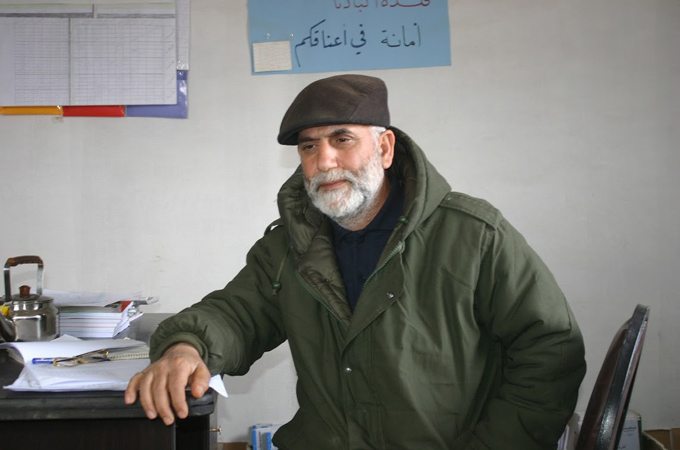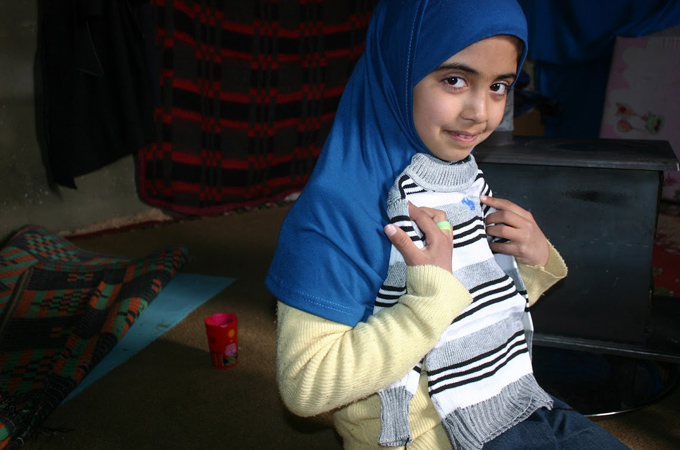Overrun Lebanese town braces for more Syrians
Expected Syrian military offensive may push even more refugees into Arsal, already teeming with too many people.

Arsal, Lebanon – Khaled lies motionless on a rusty bed in a makeshift clinic in the basement of a mosque in this now-sprawling border town.
Skin grafts crisscross the Syrian rebel’s face like lines on a map. His beard is scorched to stubble. Khaled’s eyes are shut, his lips swollen. Semi-conscious after being nearly killed by rocket fire in Syria, the 20-year-old still mumbles about going back to the battlefield in his homeland.
“This would be sixth time [he has been] injured, gotten treated, and gone back to the fighting,” his father, who sat at his bedside, said.
The older man spoke softly, trying not to disturb two other wounded fighters sleeping nearby.
The men, like Khaled, are among the latest wave of injured rebels and refugees who have flooded into Arsal in increasing numbers in recent weeks, stretching already-sparse infrastructure and deepening concerns of an imminent humanitarian catastrophe.
There are no more empty beds. Some patients are sleeping on stretchers.
Outside Khaled’s room, the medical staff – mostly Syrian refugees from the border town of Qusair – scramble to treat another rush of patients entering Arsal, 125 kilometres northeast of Lebanon’s capital Beirut.
Dozens of wounded civilians and rebels have been brought across the border to Arsal in the past week, after Syrian forces stepped up their aerial and artillery barrage of Yabroud and the surrounding Qalamoun region, ahead of an expected all-out assault on the rebel-held town.
The government has already seized the towns of Qara, Deir Attiya and Nabak, to the northeast of Yabroud, along the strategically important highway linking Damascus with the city of Homs. Most of the civilians who fled these towns are also living in Arsal now.
Qasem al-Zein, a medical doctor from Qusair, heads the only clinic in the Lebanese town, a bare-bones facility set up by Syrian refugee doctors and funded by donors.
“There are no more empty beds. Some patients are sleeping on stretchers,” he told Al Jazeera.
Refugee explosion
The town of Arsal, which had a population of 45,000 mostly Lebanese before the conflict, is now also an ad hoc home to more than 65,000 Syrians who have arrived since the civil war erupted three-years ago.
Arsal‘s mayor said more than 4,000 families arrived in just the past week, most from the nearby city of Yabroud, where fighting is intense and Khaled was wounded.
Now, the town’s inhabitants, refugee camps, schools and clinics are groaning under the weight of the newest influx, and thousands more Syrians are soon expected. At least 58 camps and tent cities have been built around the town with more are on the way.
The queue of people, lorries, cars and even livestock at the military post at the entrance to Arsal stretches into the distance. Hundreds of Syrian families have camped out in freezing temperatures in a deserted no-man’s land a few kilometres before the checkpoint.
 |
| School administrator Adnan Raad is struggling to cope with an influx of Syrian children [Basma Atassi/Al Jazeera] |
Cars with Syrian license plates now visibly outnumber those with Lebanese markings. The muddy, rocky roads of the village were not meant for the thousands of vehicles belonging to incoming Syrians and international aid organisations.
Although seriously wounded fighters such as Khaled have been rushed to Arsal for treatment, many among the slow trickle of arriving refugees have also been scarred by war.
Randa, 33, arrived with her three children after a five-hour trip on the dangerous mountainous route from Yabroud.
They are now staying in the same tent with a family of seven, separated only by a flowery tablecloth hanging up. Her children are clearly stunned by the loss of their father, killed a few days earlier by an artillery shell that struck in front of their house.
Randa said she plans to register at the local UNHCR office to become eligible to receive blankets, kitchen items and bedrolls. She expressed little hope of finding a shelter in the village itself, dismayed by the many Syrians waiting in front of her.
“The Syrian people came out to the streets for freedom. Now we’re just a bunch of beggars,” Randa said, waving at the long queue with one arm and holding her 3-year-old son in the other.
‘Bitter joke’
Life is not much easier for those who arrived earlier. Of the dozens of refugees camps in Arsal, one of the most densely populated is the “Mothers of Martyrs”, a complex of 113 concrete, 4-metre-by-4-metre rooms funded by a Kuwaiti cleric.
The Mothers of Martyrs site bears a sad distinction: it is occupied solely by widows and children who lost their husbands and fathers in Syria.
In one of the rooms lives Umm Mohammad, 47, and her seven children. The family depends solely on limited humanitarian assistance that is sporadically distributed. Umm Mohammad said she fears the influx of more people will decrease their chances of receiving more aid.
 |
| Umm Mohammad’s daughter holds up clothes provided by an aid group that were too small to fit [Basma Atassi/Al Jazeera] |
This week, they received text messages from an aid organisation asking them to come to their centre, 10km away, to register their names in order to receive some clothes.
“We had to pay 5,000 Lebanese pounds [$3.30] for a taxi to get there. They took the names of my children, their ages, and snapped photos of them. We returned to the camp on foot to save the taxi cost,” Umm Mohammad said.
The next morning they received the clothes, none of which matched the sizes of her children.
“Take a photo of these clothes. Take a photo of this bitter joke,” she told Al Jazeera, instructing her daughter to hold a tiny T-shirt in front of her body.
She then lowered her voice and said, “I am just heartbroken seeing the disappointment of my children.”
Night falls
Near the camp is the “Mother of Martyrs School”, where Umm Mohammad and other mothers send their children in the mornings. It is the only education centre in Arsal that teaches a Syrian curriculum.
Adnan Raad, the school’s administrator, was a well-known English teacher in Qusair, who continued to teach in the war-torn town until the school was bombed in April 2012.
Many of the children are coming to the school with a lot of psychological stress resulting from the horror they see in Syria.
Raad, 55, said 50 new students registered last week, adding more pressure to the small and under-funded institution. He is scrambling to fit 700 students into 13 classrooms.
“Many of the children are coming to the school with a lot of psychological stress resulting from the horror they see in Syria,” he said, adding a much larger wave of war refugees is expected to arrive next week.
Back at the hospital, Khaled’s doctors are also bracing for more arrivals. Khaled’s father, meanwhile, is seeking a way to move his son to a burn clinic elsewhere in Lebanon.
Dr Zein said during the military campaign on Qusair – which was captured last June by government troops backed by the Shia armed group Hezbollah – more than 1,300 people wounded in fighting entered Arsal in two days.
“The number of injured from Yabroud would be as large, but over a longer period,” he said. “Unlike Qusair, where residents were concentrated in a small area, Yabroud is large and mountainous, so the damage from shells is more spread out.”
As darkness falls the village of Arsal grows quiet, exposing the newly arrived Syrians to the sound of shelling and gunfire echoing from their home across the border.
Many of the daily struggles here are different for Syrian refugees, but they all share the same wish: to return to a peaceful home.